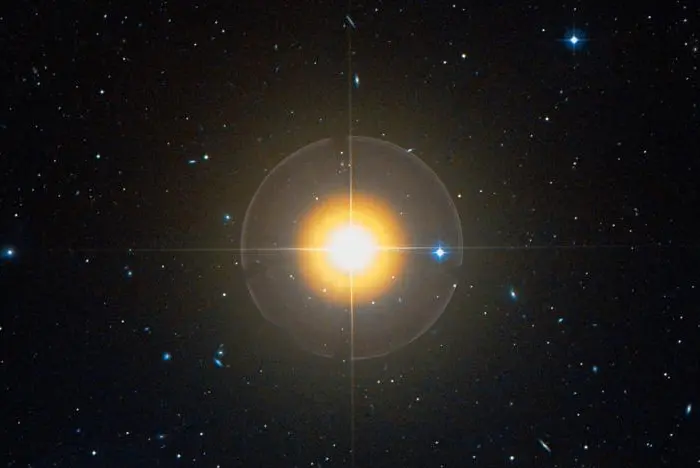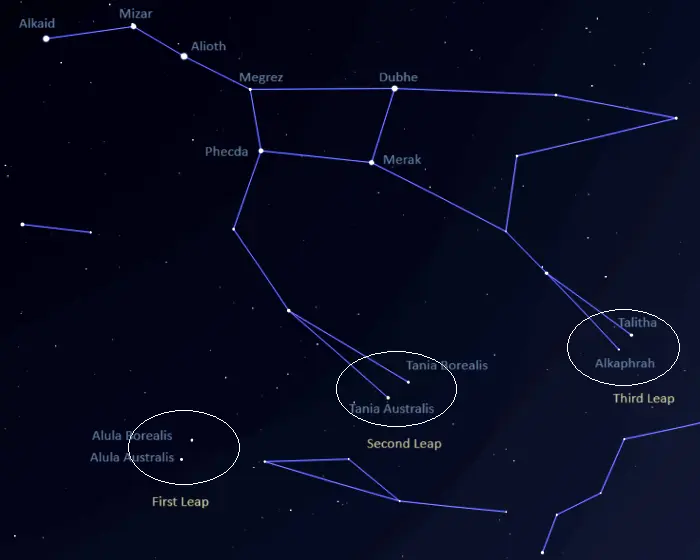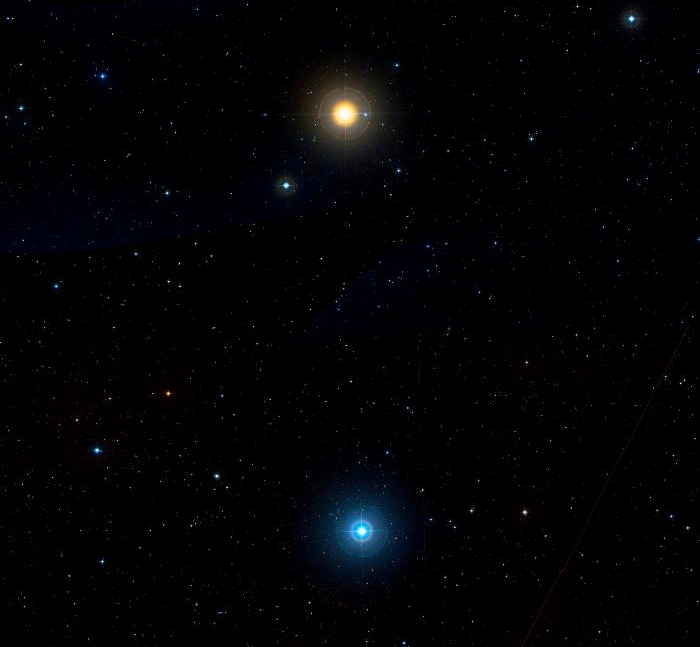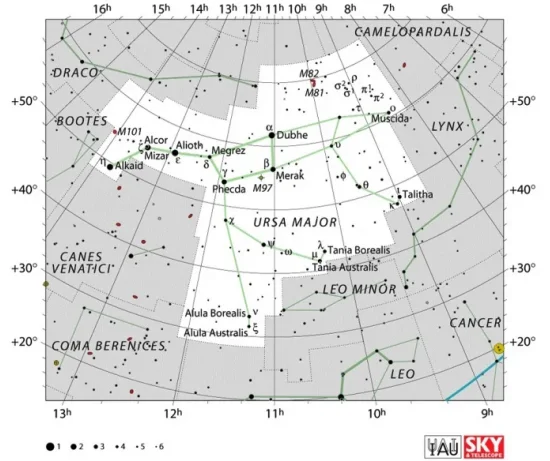Alula Borealis, Nu Ursae Majoris (ν UMa), is an orange giant star located 399 light years away in the constellation Ursa Major. It has an apparent magnitude of 3.490. It is one of the six stars that form an asterism known as the Three Leaps of the Gazelle. These stars also mark the feet of the Great Bear.
Star type
Alula Borealis is an evolved giant star of the spectral type K3 III. It has a mass 3.82 times that of the Sun. As it evolved away from the main sequence it has expanded to a size of 60 solar radii. With an effective temperature of 4,422 K, the star is 1,242 times more luminous than the Sun. It spins at 10 km/s.
Alula Borealis is still a relatively young star. It has an estimated age of around 200 million years. In spite of its young age, it has evolved fast due to its high mass and will have a much shorter life than the Sun.
Alula Borealis has an optical companion at a separation of 7.1 arcseconds. The 10th magnitude star is not related to Nu UMa but only lies in the same line of sight.

Alula Borealis (Nu Ursae Majoris), image credit: ESO/Digitized Sky Survey 2 (CC BY 4.0)
Facts
Alula Borealis forms an asterism called the Three Leaps of the Gazelle with Alula Australis (Xi Ursae Majoris), Tania Borealis (Lambda Ursae Majoris), Tania Australis (Mu Ursae Majoris), Talitha (Iota Ursae Majoris), and Alkaphrah (Kappa Ursae Majoris). The asterism appears roughly halfway between the Big Dipper and the constellation figure of Leo. In Arabic lore, it represents a gazelle that dashed across a pond after being startled by a lion. The pond is represented by the stars of what is now the constellation Coma Berenices (Berenice’s Hair).
Alula Borealis and Alula Australis form the first leap, Tania Borealis and Tania Australis the second leap, and Talitha and Alkaphrah the third leap of the gazelle. The asterism was originally known as Kafzah al Thiba’, “the springs of the gazelle.”

Three Leaps of the Gazelle, image: Stellarium
Even though they appear close to each other in the sky, Alula Borealis and Alula Australis are not physically related. Alula Australis is much closer to the Sun than it is to Alula Borealis. It lies only 28.5 light-years away.
The brightness of Alula Borealis is dimmed by 0.48 magnitudes of extinction. Without the intervening dust, the star would be about as bright as the fellow K-type giant Psi Ursae Majoris, the seventh brightest star in Ursa Major, which lies 140 light years away.
Name
The name Alula Borealis (pronunciation: /əˈluːlə bɒriˈælɪs/) is derived from the Arabic phrase Al Ḳafzah al Ūla, meaning “the first leap” or “the first spring.” It refers to the Three Leaps of the Gazelle asterism. The word borealis is Latin for “northern” or “the north side.” Nu Ursae Majoris is the northern of the two stars of the First Leap.
The International Astronomical Union’s (IAU) Working Group on Star Names (WGSN) approved the name Alula Borealis on July 20, 2016.
In traditional Chinese astronomy, Nu Ursae Majoris was known as 下台一 (Xià Tái yī), Star of First Lower Step. It was part of an asterism called Three Steps, which corresponded to the Arabic Three Leaps star pattern. The Three Steps asterism was part of the Supreme Palace Enclosure, which represented the imperial court.

Alula Borealis and Alula Australis, image credit: ESO/Digitized Sky Survey 2 (CC BY 4.0)
Location
Alula Borealis and Alula Australis appear in the region between the bowl of the Big Dipper in Ursa Major and the celestial Lion’s hindquarters. The two stars can be found along the imaginary line extended from Chertan through Zosma in the constellation figure of Leo. Alula Borealis is the northern of the two stars.
The stars of the First Leap of the Gazelle can be used to find Praecipua, the brightest star in the faint constellation Leo Minor (the Lesser Lion). Praecipua appears in the region between the two stars and the stars of the Second Leap, Tania Borealis and Tania Australis.

The location of Alula Borealis (Nu Ursae Majoris), image: Stellarium
Constellation
Alula Borealis is located in the constellation Ursa Major (the Great Bear). Ursa Major is one of the oldest constellations in the sky. It was one of the Greek constellations listed by the astronomer Claudius Ptolemy of Alexandria in the 2nd century CE. In Greek lore, it associated with the nymph Callisto, who was turned into a bear by the goddess Hera.
The Great Bear constellation stretches across 1,280 square degrees of the northern sky. It is the largest constellation in the northern celestial hemisphere and the third largest constellation in the sky, after Hydra and Virgo. Its brightest stars form the Big Dipper (the Plough), one of the most familiar features of the northern night sky.
Bright stars in Ursa Major include the A-type stars Alioth (Epsilon Ursae Majoris), Mizar (Zeta Ursae Majoris), Alcor (80 Ursae Majoris), Phecda (Gamma Ursae Majoris), Merak (Beta Ursae Majoris) and Megrez (Delta Ursae Majoris), the orange giants Dubhe (Alpha Ursae Majoris) and Psi Ursae Majoris, and the hot blue B-type star Alkaid (Eta Ursae Majoris).

Ursa Major constellation map by IAU and Sky&Telescope magazine (Roger Sinnott & Rick Fienberg) (CC BY 3.0)
The constellation also hosts the yellow dwarf Chalawan (47 Ursae Majoris) with three known exoplanets, the orange dwarf HIP 57274, also with three planets, the yellow giant Muscida (Omicron Ursae Majoris), and the red dwarf Lalande 21185, the fourth nearest star system to the Sun (after Alpha Centauri, Barnard’s Star and Wolf 359).
Bright deep sky objects in Ursa Major include the planetary nebula Messier 97 (the Owl Nebula), Bode’s Galaxy and the Cigar Galaxy (M81 and M82), the Pinwheel Galaxy (M101), and the galaxies Messier 108 and Messier 109.
The best time of the year to observe the stars and deep sky objects in Ursa Major is during the month of April, when the constellation appears higher above the horizon in the early evening. The entire constellation is visible from locations between the latitudes 90° N and 30° S.
The 10 brightest stars in Ursa Major are Alioth (Epsilon UMa, mag. 1.77), Dubhe (Alpha UMa, mag. 1.79), Alkaid (Eta UMa, mag. 1.86), Mizar (Zeta UMa, mag. 2.04), Merak (Beta UMa, mag. 2.37), Phecda (Gamma UMa, 2.438), Psi Ursae Majoris (mag. 3.01), Tania Australis (Mu UMa, mag. 3.06), Talitha (Iota UMa, mag. 3.14), and Theta Ursae Majoris (mag. 3.166).
Alula Borealis – Nu Ursae Majoris
| Spectral class | K3 III |
| U-B colour index | +1.550 |
| B-V colour index | +1.400 |
| Apparent magnitude | 3.490 |
| Absolute magnitude | −2.47 ± 0.16 |
| Distance | 399 ± 8 light-years (122 ± 3 parsecs) |
| Parallax | 7.9823 ± 0.4825 mas |
| Radial velocity | -9.63 ± 0.38 km/s |
| Proper motion | RA: −26.139 ± 0.194 mas/yr |
| Dec.: 27.892 ± 0.154 mas/yr | |
| Mass | 3.82 ± 0.23 M☉ |
| Luminosity | 1,242 ± 81 L☉ |
| Radius | 60 R☉ (58.71 – 61.24 R☉) |
| Temperature | 4,422 ± 26 K |
| Metallicity | –0.04 dex |
| Age | 200 ± 30 million years |
| Rotational velocity | 10 km/s |
| Surface gravity | 1.89 cgs |
| Constellation | Ursa Major |
| Right ascension | 11h 18m 28.7372062295s |
| Declination | +33° 05′ 39.501852796″ |
| Names and designations | Alula Borealis, Nu Ursae Majoris, ν Ursae Majoris, ν UMa, 54 Ursae Majoris, 54 UMa, HD 98262, HR 4377, HIP 55219, SAO 62486, FK5 425, BD+33 2098, AG+33 1074, PPM 75790, PLX 2626.00, GC 15547, GCRV 6924, JP11 2048, SKY# 21526, SRS 30425, GSC 02520-02631, N30 2653, NSV 18715, IRC +30230, PMC 90-93 307, GEN# +1.00098262, RAFGL 1475, DO 14388, CSI+33 2098 1, ROT 1681, WEB 9950, UBV 10291, UBV M 16964, uvby98 100098262, TD1 15522, TIC 144294421, TYC 2520-2631-1, WISE J111828.70+330538.9, IRAS 11157+3322, 2MASS J11182874+3305393, Gaia DR2 757565233819639168, Gaia DR3 757565233820538752, STF 1524A, ADS 8123 A, CCDM J11185+3306A, IDS 11131+3338 A, WDS J11185+3306A |